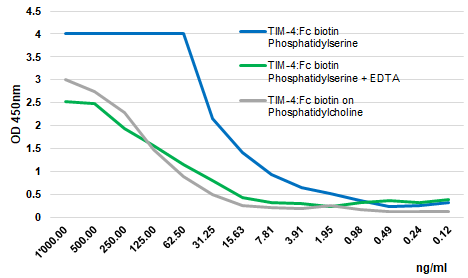
Tim-4 (mouse):Fc (human) (rec.) (Biotin)
AG-40B-0180B
Product group Proteins / Signaling Molecules
Overview
- SupplierAdipoGen Life Sciences
- Product NameTim-4 (mouse):Fc (human) (rec.) (Biotin)
- Delivery Days Customer10
- CertificationResearch Use Only
- Concentration0.1 mg/ml
- ConjugateBiotin
- Estimated Purity>95%
- Scientific DescriptionExtracellular vesicles (EVs) are released by a variety of cells into the cellular microenvironment and have the natural ability of delivering different cargos and carry bioactive molecules such as non-coding RNA, miRNAs, genomic DNA, lipids, growth factors and signaling molecules. EVs can be divided into exosomes (30-100nm), microvesicles (100-1000nm) and apoptotic bodies (>1000nm). EVs play substantial roles not only in the regulation of normal physiological processes but also in disease pathogenesis and their cargo reflects the status of parental cells at the time of secretion. Various studies are currently being conducted to develop therapeutic and diagnostic methods targeting or utilizing EVs. Therefore, developing ideal methods for isolating and quantifying EVs is an active area of research. EVs express phosphatidylserine (PS) on their outer lipid bilayer. Tim-4 (T cell immunoglobulin and mucin domain-containing protein 4) is a single-pass type I membrane protein which belongs to the immunoglobulin superfamily and TIM family. Tim-4 contains one Ig-like V-type (immunoglobulin-like) domain. It is expressed on dendritic cells and macrophages. Tim-4 plays an important role in the proliferation of T helper type 2 (Th2) cells. Tim-4 binds to phosphatidylserine (PS) on the surface of apoptotic cells in a calcium-dependent manner and mediates phagocytosis of apoptotic cells. EV membranes are rich in phosphatidylserine (PS) and Tim-4 binds to PS on the surface of EVs. A new protocol from the group of Prof. Rikinari Hanayama describes an affinity-based method for isolating EVs using streptavidin magnetic beads conjugated with Tim-4-biotin to capture EVs in a calcium-dependent manner [2]. This new protocol could replace ultracentrifugation, that is the most commonly used method for purifying EVs. This new Tim-4-dependent method gives good yield, high purity and allows isolation of all populations of EVs compared to other approaches (ultracentrifugation, PEG precipitation or selected antibodies immunoprecipitation). See Reference 2 for a complete protocol (Download available). - Protein. The extracellular domain of mouse Tim-4 (aa 22-279) is fused to the N-terminus of the Fc region of human IgG1. Source: CHO cells. Endotoxin content: 95% (SDS-PAGE). Extracellular vesicles (EVs) are released by a variety of cells into the cellular microenvironment and have the natural ability of delivering different cargos and carry bioactive molecules such as non-coding RNA, miRNAs, genomic DNA, lipids, growth factors and signaling molecules. EVs can be divided into exosomes (30-100nm), microvesicles (100-1000nm) and apoptotic bodies (>1000nm). EVs play substantial roles not only in the regulation of normal physiological processes but also in disease pathogenesis and their cargo reflects the status of parental cells at the time of secretion. Various studies are currently being conducted to develop therapeutic and diagnostic methods targeting or utilizing EVs. Therefore, developing ideal methods for isolating and quantifying EVs is an active area of research. EVs express phosphatidylserine (PS) on their outer lipid bilayer. Tim-4 (T cell immunoglobulin and mucin domain-containing protein 4) is a single-pass type I membrane protein which belongs to the immunoglobulin superfamily and TIM family. Tim-4 contains one Ig-like V-type (immunoglobulin-like) domain. It is expressed on dendritic cells and macrophages. Tim-4 plays an important role in the proliferation of T helper type 2 (Th2) cells. Tim-4 binds to phosphatidylserine (PS) on the surface of apoptotic cells in a calcium-dependent manner and mediates phagocytosis of apoptotic cells. EV membranes are rich in phosphatidylserine (PS) and Tim-4 binds to PS on the surface of EVs. A new protocol from the group of Prof. Rikinari Hanayama describes an affinity-based method for isolating EVs using streptavidin magnetic beads conjugated with Tim-4-biotin to capture EVs in a calcium-dependent manner. This new protocol could replace ultracentrifugation, that is the most commonly used method for purifying EVs. This new Tim-4-dependent method gives good yield, high purity and allows isolation of all populations of EVs compared to other approaches (ultracentrifugation, PEG precipitation or selected antibodies immunoprecipitation). See Reference 2 for a complete protocol (Download available).
- Storage Instruction-20°C,2°C to 8°C
- UNSPSC12352202

